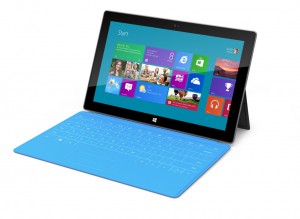Share This
Related Posts
Tags
Surface Tablet
By Yardi Blog Staff on Jul 2, 2012 in Technology
Earlier this month, Microsoft pulled an Apple move and debuted its new Surface tablet to a hushed crowd of tech media bigwigs. It had all the hallmarks of a classic Steve Jobs production: a rented out art studio space, regal staging, and fanfare designed to shock & ahhh. This aggressive cribbing from the productions that launched the iPad was intentional: Microsoft designed the Surface to compete head-on with Apple and become the market’s first iPad killer.
They just might be onto something. And they also may have launched the product that will prompt consumers to decide between a tablet-style device, like a Surface or an iPad, or an ultra lightweight laptop, like an Ultrabook. Price points for Surface are expected to be slightly higher than for the iPad, meaning that it won’t be competing in the same space as Google’s low-cost Nexus Tablet, which is now available for $199, but with the more expensive, high performance Ultrabooks.
Surveying the Surface
It’s the not-so-little things that stand out so far and make the Surface RT (basic model) and Surface Windows 8 Pro (all-in) look like they might make good on those David vs. Goliath aspirations:
- It’s got a keyboard. When the Surface keyboard was revealed, you could practically hear a chorus of angels sing and wild cheering from the balconies and the sound of a million hearts shouting forth the virtues of love, peace, and happiness. ‘Cause that’s how stoked people are to have a tablet with a real keyboard. The Touch Cover model gives solid keyboard performance, the Type Cover replicates true keyboard feel. Either way, Surface provides consumers the platform to do a lot more than just send off tweets and emails.
- It’s bigger. Size matters, and at 10.6 inches the Surface display has almost a full inch on the iPad; it’s also formatted to wide screen ratios. For the Windows 8 Pro model this means significant extra bulk (13.5mm thick, around 2 lbs.), but it’s still a wisp compared to a notebook computer. The RT model is virtually identical to the iPad in thickness and heft.
- USB ports included. When consumers complained to Apple that the iPad didn’t have any USB ports, it turns out Microsoft was the one that listened. Two ports on each model means built-in versatility: added storage, Wi-Fi-less printing, external capabilities, and more.
- It’s got power. The Windows 8 Pro runs on Intel’s i5 processor, with 128 gigabytes internal memory (double that of the iPad). Surface is clearly designed for users who are looking for performance capabilities beyond just gaming, social media, and entertainment.
Potential hiccups?
Hands-on time with the Surface has been notably scarce, so there has been little opportunity to put the device through a serious workout. Naysayers will focus on circumstantial evidence and the iPad’s undefeated record. Apple has beat down the tablet competition feature-by-feature, slaying a host of Android rivals and Blackberry’s stillborn Playbook, and it remains head and shoulders above Amazon’s bargain model Kindle Fire.
Microsoft’s own history offers additional reasons to scoff at the notion of an outright victory. Their performance in the hardware market has been underwhelming, marked by spotty commitment – Zune, anybody? – or still-unmet expectations, like the Xbox’s inability to escape the shadow of various Sony PlayStation and Nintendo consoles. Surface will have to prove that it is capable of surpassing its dubious pedigree.
Haters might even point to a little hiccup during the Surface presentation:
Surface’s first edition will be wi-fi only, which could be a limitation for industries like real estate that seek total mobility for their business. iPad users who purchase a data plan can use their devices as they would a smartphone. Customers will have to decide whether they want a tablet that they can use just about anywhere or just from home, office, coffee shop or other wi-fi equipped location.
Surface’s price point is expected to be around $599, the same as a new iPad, and Surface for Windows 8 will be $200 more. First time tablet users seeing a bargain may still gravitate toward iPad, where older models can now be had at retail for $399, but even more so toward the Nexus Tablet, which feels like a bargain at $199. Surface is expected to hit stores by the end of the year.
Is a keyboard the feature that could make a big difference in your tablet purchase decision, or would you gravitate toward an Ultrabook instead? iPad fans and Apple enthusiasts, we want to hear from you too, give us your take on whether this tablet will give iPad a run for the money.

